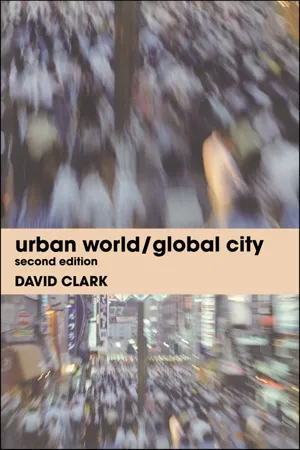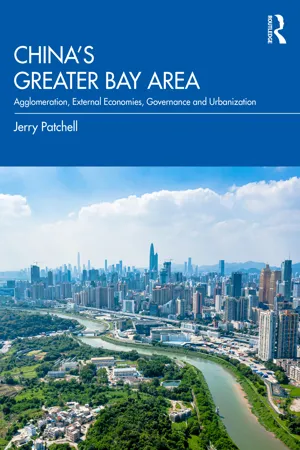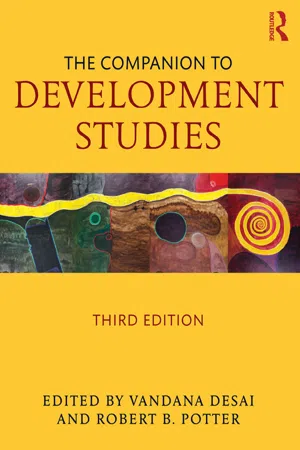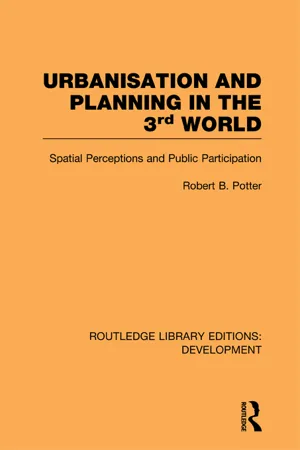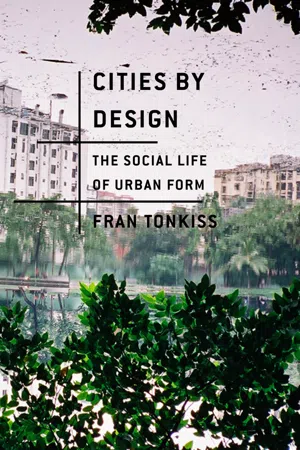Social Sciences
Urbanisation
Urbanisation refers to the increasing population concentration in urban areas, often accompanied by the growth of cities and towns. It involves the expansion of infrastructure, services, and industries to meet the needs of a growing urban population. Urbanisation has significant social, economic, and environmental implications, influencing patterns of employment, housing, transportation, and resource consumption.
Written by Perlego with AI-assistance
Related key terms
Related key terms
1 of 4
Related key terms
1 of 3
11 Key excerpts on "Urbanisation"
- eBook - ePub
- Mehran Kamrava(Author)
- 2012(Publication Date)
- Routledge(Publisher)
One of the most immediate and dramatic consequences of industrial development in the developing world is rampant and unchecked Urbanisation, which, since the Second World War, has proceeded at a dizzying pace. Even in countries where significant portions of the population still live in rural areas, sprawling metropolitan centres with large concentrations of urban dwellers, cramped houses and narrow streets and high-rise buildings have appeared. Development, in its broadest sense, has entailed not only economic and industrial changes but rapid Urbanisation and the growth of cities. In fact, the preference of Third World governments and industrial concerns alike to establish factories and plants near existing large urban areas has resulted in the development of a complementary and mutually reinforcing relationship between the two processes of industrialisation and Urbanisation. On the one hand, industrialisation serves as a main locus in enhancing the economic and political powers of existing urban centres as well as population and geographic size. On the other hand, cities have facilitated access to and provided the infrastructure, the skilled and the abundant labour and almost all of the other ingredients that are necessary for industrial growth and development. It is within this context, one which considers industrialisation and Urbanisation as intertwined and complementary processes, that both phenomena need to be examined. Industrialisation and its various economic, political and cultural ramifications for developing countries were discussed in the previous chapter. This chapter focuses on the causes, processes and consequences of Third World Urbanisation. However, before examining these developments in detail, some general observations regarding the nature and characteristics of Urbanisation in the developing world are in order.Urbanisation is commonly understood as a rise in the proportion of people living in urban as opposed to rural areas. More specifically, it refers to the ‘transition from a dispersed pattern of human settlement to one concentrated around cities and towns’.1 In addition to changes in patterns of residence, the change from rural to urban surroundings carries with it definite, though at times gradual and latent, alterations in the values and the behaviour of those involved. Urbanisation involves considerably more than a mere change in residence from rural to urban areas. It sets into motion a series of social and cultural processes which fundamentally influence the course and direction of social change and the political culture of the country involved.2 Rural migrants to the cities, having left their original surroundings for urban areas in search of better jobs and higher living standards, become subjects of an intense social and cultural turmoil set off by Urbanisation. Sooner or later, willingly or through force of time, even the more recent arrivals develop an ‘urbanised’ culture of their own, one which resembles neither the values they adhered to in the countryside nor those commonly held by the urban mainstream.In addition to providing great impetus for social and cultural change, Urbanisation has the potential of serving as means for the accumulation of capital, and therefore economic and political power, not only for rural and urban residents but also for the state, local investors, and multinational firms. Some observers have even gone so far as to refer to cities as ‘theatres of accumulation’, arguing that metropolitan centres provide both the institutional framework and the modus operandi for local oligopoly capital, transnationals, and modernising states.3 - eBook - ePub
- David Clark(Author)
- 2004(Publication Date)
- Routledge(Publisher)
3Urban growth and Urbanisation: historical patterns
By the end of this chapter you should:- be able to distinguish between urban growth, Urbanisation and the spread of urbanism;
- understand the main ways in which urban growth and Urbanisation are occurring;
- be familiar with the concept of counterUrbanisation and understand its causes;
- understand the ways in which the distribution of population in and around cities changes over time;
- be aware of the major changes which have occurred in the course of global urban development and the reasons for them.
Introduction
The present pattern of global urban development is merely the most recent product of processes of urban change that began over 8,000 years ago. It represents an intermediate stage in the progression from a wholly rural to what will possibly be a completely urban world. The global urban pattern is changing in three different and unconnected ways through urban growth, Urbanisation and the spread of urbanism. Urban growth occurs when the population of towns and cities rises. Urbanisation refers to the increase in the proportion of the population that lives in towns and cities. Urbanism is the name that is most commonly used to describe the social and behavioural characteristics of urban living that are being extended across society as a whole as people adopt urban values, identities and lifestyles. This chapter and Chapter 4 identify and attempt to identify and account for recent patterns of urban growth and Urbanisation at the global scale. The origins and spread of urbanism are the focus of Chapter 6 .Urban growth and Urbanisation are separate and independent trends. Urban growth refers to the absolute increase in the size of the urban population. It occurs both through natural increase, which is an excess of births over deaths, and through net in-migration. In most cities both factors operate together and reinforce each other, although the relative balance varies from place to place and at different times. Growth rates are compounded when the in-migrants are young adults. These are the most fertile age group and their influx is likely to raise the rate of natural increase. However, if the in-migrants are predominantly of one sex, the accompanying rate of natural increase is likely to be lower. As an actual rather than a percentage figure, urban growth is not subject to any ceiling. It can take place without Urbanisation occurring so long as rural growth occurs at the same rate. It is likely to continue after Urbanisation has ceased, as the population, which will all be living in urban places, goes on growing through the excess of births over deaths. - eBook - ePub
Environmental Psychology
Behaviour and Experience In Context
- Tony Cassidy(Author)
- 2013(Publication Date)
- Psychology Press(Publisher)
Chapter Six Urbanisation, movement, and spaceIn this chapter we turn to the social environment in terms of Urbanisation, travel, and the use of space. Living in cities involves a range of experiences that differ from living in rural areas and we will consider these under sources of stress in the city and how cities influence behaviour generally in comparison to the effects of rural environments. We will then turn to the relationship between people and space, i.e. how people relate to the space in which they live, and to each other within that space. This subsumes the topics of personal space, crowding, territoriality, and privacy. Finally we will consider the experience of travel and the problems associated with commuting and travelling as part of the leisure domain of life.UrbanisationStatistics on human population of the earth make interesting and frightening reading. From a mere five million in 6000 BC, the earth’s population has grown to a current approximate six billion. The rate of growth is also increasing. For example, it took 200 years (1600–1800) for the population to double in size. Currently it is estimated that the world population doubles about every 35 years. As Veitch and Arrkelin (1995) put it, the current rate of growth is the equivalent of a new city the size of Chicago every month. The vast majority of people live in a very small area of the world’s surface. For example, it is estimated that 70% of Americans live in only 2% of the overall area of the USA. This concentration of populations is found in cities. The number of people living in cities means increased crowding, threats to territoriality, invasions of personal space, and reductions in privacy, and will be discussed in the sections to follow on people in spatial relations to each other. However there are some specific aspects of city versus country living which need to be explicated first. It is very clear from talking to people that previous experience is very important, in that most country people will find cities intolerable except for short periods whereas most city dwellers will long for the hustle and bustle of the city after short periods in the country. - 1 Urbanisation AND THE URBAN QUESTIONFor the vast majority, cities are polluted, unhealthy, tiring, overwhelming, confusing, alienating. They are places of … insecurity, poor living conditions and dejected isolation for the many at the bottom of the social ladder daily sucked into them.(Amin 2006: 1019)It has become something of a cliché to ascertain that we now live in an urban world where most of the world’s population resides in settlements described as urban. Given this, it follows logically that the majority of research in human geography relates to cities in some shape or form, and comments on the social, economic or political circumstances faced by urbanised populations. Likewise, most geographical knowledge production occurs in universities and research institutes based in cities, making the city both a key venue of geographic knowledge production, as well as its principal field site. But although most human geography research can be described as urban – in the sense that it is produced in or relates to cities – a surprisingly small amount of contemporary geographical work is concerned with defining the city itself. To put this somewhat differently, while there is much geographical work carried out in cities that contributes to social, economic, political or cultural theory, most say very little, if anything, about Urbanisation as a process. In fact, in the vast majority of the human geographical research that has the city as its context or backdrop, the question of what constitutes ‘cityness’ remains elusive.This said, there are multiple theories of Urbanisation developed by sociologists and urban scholars over the last 150 years or so which provide some inroads into this issue. Crucially, these theories do not define cities in terms of what they contain (i.e. internal attributes like population size or density) but instead theorise urbanism as a distinct ‘way of life’, fundamentally different from the forms of life evident in more traditional, rural societies. In these theories, there is a degree of conflation between the emergence of cities and the emergence of modern societies, with some accounts inferring these are one and the same (i.e., modern society is a society of cities). This means that some traditional theories of Urbanisation say remarkably little about the role of cities in creating, and sustaining, modern society (Brenner 2009). Redressing this, new approaches to the study of Urbanisation emerged from the 1970s onwards which explicitly addressed the ‘urban question’ – namely, what role do cities play in the processes of production and exchange that are integral to capitalist society? This is a question at the heart of urban political economy , a theoretical approached largely indebted to the ideas of Karl Marx. Reflecting the current hold Marxist and neo-Marxist thought has on urban studies, this chapter charts the shift from descriptive to more critical urban theories, and the move from questions of what the city is , to what the city does
- eBook - ePub
Kingsley Davis
A Biography and Selections from His Writings
- David M. Heer(Author)
- 2017(Publication Date)
- Routledge(Publisher)
Some years ago my associates and I at Columbia University undertook to document the progress of urbanization by compiling data on the world’s cities and the proportion of human beings living in them; in recent years the work has been continued in our center—International Population and Urban Research—at the University of California at Berkeley. The data obtained in these investigations are reflected in the illustration on the following page, which shows the historical trend in terms of one index of urbanization: the proportion of the population living in cities of 100,000 or larger. Statistics of this kind are only approximations of reality, but they are accurate enough to demonstrate how urbanization has accelerated. Between 1850 and 1950 the index changed at a much higher rate than from 1800 to 1850, but the rate of the change from 1950 to 1960 was twice that of the preceding 50 years! If the pace of increase that obtained between 1950 and 1960 were to remain the same, by 1990 the fraction of the world’s people living in cities of 100,000 or larger would be more than half. Using another index of urbanization—the proportion of the world’s population living in urban places of all sizes—we found that by 1960 the figure had already reached 33 percent.Clearly the world as a whole is not fully urbanized, but it soon will be. This change in human life is so recent that event he most urbanized countries still exhibit the rural origins of their institutions. Its full implications for man’s organic and social evolution can only be surmised.In discussing the trend—and its implications insofar as they can be perceived—I shall use the term “urbanization” in a particular way. It refers here to the proportion of the total population concentrated in urban settlements, or else to a rise in this proportion. A common mistake is to think of urbanization as simply the growth of cities. Since the total population is composed of both the urban population and the rural, however, the “proportion urban” is a function of both of them. Accordingly cities can grow without any urbanization, provided that the rural population grows at an equal or a greater rate.Historically urbanization and the growth of cities have occurred together, which accounts for the confusion. As the reader will soon see, it is necessary to distinguish the two trends. In the most advanced countries today, for example, urban populations are still growing, but their proportion of the total population is tending to remain stable or to diminish. In other words, the process of urbanization—the switch from a spread-out pattern of human settlement to one of concentration in urban centers—is a change that has a beginning and an end, but the growth of cities has not inherent limit. Such growth could continue even after everyone was living in cities, through sheer excess of births over deaths.The difference between a rural village and an urban community is of course one of degree; a precise operational distinction is somewhat arbitrary, and it varies from on nation to another. Since data are available for communities of various sizes, a dividing line can be chosen at will. One convenient index of urbanization, for example, is the proportion of people living in places of 100,000 or more. In the following analysis I shall depend on two indexes: the one just mentioned and the proportion of population classed as “urban” in the official statistics of each country. In practice the two indexes are highly correlated; therefore either one can be used as an index of urbanization. - eBook - ePub
Eastern and Southern Africa
Development Challenges in a volatile region
- Debby Potts, T.A.S. Bowyer-Bower(Authors)
- 2016(Publication Date)
- Routledge(Publisher)
These shifts in the urban policy environment over time provide the backdrop to this chapter on Urbanisation in eastern and southern Africa. Urbanisation is too broad a topic to provide comprehensive coverage of all its facets. Here the focus is mainly on processes within cities, rather than debates about urban systems and hierarchies. First, the nature and composition of urban growth rates over time are analysed. Second, changes in the way urban people make their livings are examined. Finally, as an example of trends in urban service provision, the urban housing sector is discussed.Urban growth in eastern and southern AfricaMany cities and towns in the region are not growing nearly as fast as they did in the 1960s and 1970s. A number of reasons can be advanced to explain this. Some of them are basic characteristics of Urbanisation processes, although they are seemingly often forgotten by regional urban analysts. One important factor is that a given number of net in-migrants to centres with small populations translates into high rates of annual population growth, but yields a much smaller growth rate if added to a much larger urban centre. Also, in countries with extremely low levels of Urbanisation, the pool of potential rural–urban migrants in relation to current urban residents is huge: thus as urban levels increase (e.g. to over 50 per cent in today’s South Africa), even if the propensity to migrate to town from rural areas remains the same, the rate of growth yielded by in-migration drops significantly. This means that as urban centres get bigger, and as the population becomes more urbanised, the rates of growth naturally tend to drop.2 - eBook - ePub
China's Greater Bay Area
Agglomeration, External Economies, Governance and Urbanization
- Jerry Patchell(Author)
- 2023(Publication Date)
- Routledge(Publisher)
Part 5 Urbanization
DOI: 10.4324/9781003027942-12The last major topic to be covered is the complex process of urbanization and the creation of cities. First and foremost, urbanization is the bringing of large numbers of people together in a relatively small area where they will build lives supported by occupations in manufacturing or service industries. Urbanization is also the construction of a built environment—the infrastructure, residences and commercial areas and recreational facilities we expect in cities. In addition, urbanization concerns the provision of many services such as healthcare, education, social welfare services and recreation that can be organised and delivered more effectively in a densely-populated area. Most importantly, urbanization creates the conditions for our lifestyles, livelihoods, wellbeing and quality of life.Though urbanization is often an outcome of economic development, it also drives and diversifies economic development. This section thus proceeds on the basis that in the GBA agglomeration external economies have been foundational for development. Export or localisation economies are the engines of development because the industry they provide brings people and capital to the region. In the fourth section, we examined how government and governance facilitate not only economic development but also urbanization. In this section on urbanization, both economics and governance remain important influences. However, the emphasis turns to the actual urbanization processes in populating the GBA, constructing the built environment and providing services. Although the focus is on urbanization processes, it will also become clear that they can be important drivers for the GBA’s further economic development, especially as services become more sophisticated and generate new export activities. In fact, it is important to recognise that the creation of the built environment and the supply of services to the people may be a dominant force in maintaining cumulative causation. - eBook - ePub
- Vandana Desai, Rob Potter, Vandana Desai, Vandana Desai, Rob Potter(Authors)
- 2014(Publication Date)
- Routledge(Publisher)
Part 5 Urbanization and development Editorial introductionUrban places in poor- and middle-income nations currently house close to three-quarters of the world’s total urban population. Although we frequently associate this with the growth of very large cities – those with a million or more inhabitants – and indeed large urban agglomerations have shown great growth; in fact, in much of the world, the majority of urban residents are living in cities considerably smaller than one million. It is in these areas of a range of sizes that jobs will be needed, homes built, schools and social services provided and environments suitably maintained in a context of good overall governance. Stated in these terms the challenges faced are revealed as considerable.To put this overview into historical context, it was the Second United Nations Conference on Human Settlements, customarily referred to as ‘Habitat II’, held in Istanbul, Turkey, in 1996 that attested to the continuing importance of the urbanization process in developing societies. In the period since 1950, rapid urbanization has become one of the principal hallmarks of developing nations. It is the magnitude of the changes that are occurring which underscores the salience of such urban processes, for it is generally accepted that, on average, the conditions to be found in the rural areas of developing countries are much poorer than those that are to be encountered in the towns and cities.It is now well established that in the contemporary world, for every urban dweller living in the affluent developed world, two exist in the poorer cities and towns of the developing world. In fact, by the end of the first quarter of the twenty-first century, this ratio is set to have risen to three to one in favour of urban residents in the developing world. This rapid rise in both urbanization (the proportion of the population living in urban places), and urban growth - eBook - ePub
Urbanisation and Planning in the Third World
Spatial Perceptions and Public Participation
- Robert Potter(Author)
- 2012(Publication Date)
- Routledge(Publisher)
Figure 2.5 and it is envisaged that high density urban lineaments will eventually connect the urban cores within Latin America, Africa and Asia. The term ‘ecumenopolis’ or world city is used to indicate a functionally integrated urban whole and is obviously not intended to imply complete physical coverage of the world's land surface. In order to produce their forecast, Doxiadis and Papaioannou assumed world populations of 6,430 millions by 2000 and 9,600 millions by 2050, of which 71.5 per cent would be living in cities. They then looked at the habitability of different areas of the globe in 2100 according to climate, elevation, water supply and thereby ascertained areas for possible future urban development. These were then used to define a theoretical configuration of global urban centres and growth axes. The work subsequently projected the likely settlement pattern assuming world populations of 20,000 millions by 2100 and 50,000 millions by 2200. The authors sub-title their book “the inevitable city of the future” and although some may remain unconvinced of this inevitability, the historical course of world Urbanisation and its present speed certainly make such predictions seem increasingly plausible.Figure 2.5: Ecumenopolis-the global prospect? (Source: Doxiadis and Papaioannou ,1974)CITIES, SURPLUSES, ELITES AND DEVELOPMENT: FINAL PERSPECTIVES
Cities and urban modes of living are here to stay and the ways in which individual cities and systems of settlements evolve over the next 70 years and beyond will be crucial variables in the process of global development. One important lesson that can be drawn from the review of Urbanisation provided in the present chapter is that the character and form of Urbanisation and urbanism cannot be divorced from the structure and development of societies as a whole. It follows, therefore, that structurally speaking, changes in societal organisation are needed to effect urban change.We are witnessing the final stages of a process of rapid Urbanisation that started some 5,500 years ago, but which has only become a truly global phenomenon during the past 150 years. Historically, it has been shown that the development of cities has been based on changes in social organisation, so that increasing occupational specialisation and social differentiation are direct correlates of the process of Urbanisation. Thus, some writers argue most strongly that conflicts between social groups have had a direct bearing on the pattern and form of world Urbanisation (Roberts, 1978; Gilbert and Gugler, 1982). Certainly, it is undoubtedly the case that cities have always served and been associated with elite groups, whether a religious and military group as in Mesopotamia, an expatriate elite as in the mercanitle-colonial city or the corporate interests of present-day multinational companies. - eBook - ePub
Cities by Design
The Social Life of Urban Form
- Fran Tonkiss(Author)
- 2014(Publication Date)
- Polity(Publisher)
Even so, the twenty-first century ‘global shift’ in economic power towards low- and middle-income countries, and Asian economies in particular (see Dicken 2007), has been inseparable from a marked shift in urban population patterns. Current trends of urban growth have a particular spatial distribution: the urban population of China is now as large as the urban population in Europe as a whole, while India’s urban populace is larger than North America’s. It is worth noting that – as in the case of relative economic power – the growth of urban Asia into the twenty-first century may represent the reversal of a quite brief historical ‘blip’ rather than any unprecedented new development. Historically, the Asian powers of China and India have been urban as well as economic giants. Together they accounted for nearly 50 per cent of world economic output in 1820; by the 1970s this share had fallen to less than 10 per cent, but by the early 2000s had recovered to around 20 per cent, with some way – presumably – to go (see Frank 1998; Maddison 2001). Similarly, in 1800 sixty-four of the world’s one hundred largest cities were in Asia; in 2000 the region had forty-nine, the majority of these in South and East Asia (Satterthwaite 2007: vi). In parallel with the movement of economic weight and power from the established ‘triad’ of the United States, Western Europe and Japan, the global urban league is changing with accelerated growth of cities in South and East Asia and – to a lesser degree – in sub-Saharan Africa, and with low or no growth projected for the largest cities in Europe and the United States. These patterns of urban development vary, from the state-led urbanization of the Chinese boom (which has seen the development of some fifty new cities over one million since the 1990s) to different patterns of ‘unplanned’ urbanization driven by both positive ‘pull’ factors (including economic growth and liberalization, improving urban infrastructure and provision) and negative ‘push’ factors (such as civil and military conflict, or environmental crisis).A common factor across these different urban contexts is significant patterns of in-migration into cities – both internal (most notably in China) and transnational (as seen in a number of sub-Saharan African cities). Rural-to-urban migration is a key factor in current processes of urbanization, but this also varies by nation and region. Cities grow in three ways: through natural population growth (net birth rates); inward migration; and spatial expansion and consolidation incorporating peri-urban or rural populations. To take the three countries that currently host the world’s largest urban populations: internal migration and urban consolidation is almost wholly responsible for current and predicted urban growth rates in China; two-thirds of India’s urban growth in the first half of the twenty-first century is projected to result from urban migration and expansion, with one-third coming from natural population increase; and in the already highly urbanized United States, urban growth will largely come from an overall increase in population numbers, likely to be driven by non-white and Hispanic groups (United Nations 2012: 14). Where urban populations are stagnating or declining – as in much of urban Europe – low birth rates and certain trends for outward migration from cities each take a causal share. - David Drakakis-Smith(Author)
- 2012(Publication Date)
- Routledge(Publisher)
Zelinsky (1971), for example, assumed that the onset of modernisation would bring massive migration from the countryside into the towns. He ignored the very visible fact that the labour migration encouraged in most colonies was frequently very selective and thus reasonably limited in scale. The physical evidence of this selectivity can be seen in the present townscapes of North Africa where the sizeable foreign populations had, prior to independence, built extensive modern residential quarters for themselves whilst restricting the indigenous migrants to the decaying medinas or old quarters. Elsewhere in the Third World, there is evidence to show that in several of the largest South and Southeast Asian countries the level of Urbanisation has increased slowly in spite of the growing rural awareness of the modernisation process which is occurring in the cities. In Indonesia, for example, the percentage of urban dwellers rose from 15 per cent to only 18 per cent of the total population between 1960 and 1975, in India during the same period the urban population increased by only 3 per cent to 21 per cent of the total. Nor is the feature confined to national trends; in Sri Lanka the population of Greater Colombo expanded by a mere 2 per cent between 1947 and 1975. This was less than the rate of increase in the total population of the country and is markedly at variance with existing theory on the nature of urban primacy (Marga Institute 1976). Not all countries in the Third World have experienced a heavy cityward movement of people and in some migrants form only a minor fraction of the overall urban population, although the problem is usually worse in primate cities. On the other hand, in some Asian countries, such as Malaysia and the Philippines, there is considerable evidence to show that the ‘transitional shift’ of population to the urban centres is well under way (NEDA 1974/5)
Index pages curate the most relevant extracts from our library of academic textbooks. They’ve been created using an in-house natural language model (NLM), each adding context and meaning to key research topics.
Explore more topic indexes
Explore more topic indexes
1 of 6
Explore more topic indexes
1 of 4

